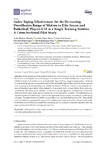Mostrar o rexistro simple do ítem
Ankle Taping Effectiveness for the Decreasing Dorsiflexion Range of Motion in Elite Soccer and Basketball Players U18 in a Single Training Session: A Cross-Sectional Pilot Study
| dc.contributor.author | Romero Morales, Carlos | |
| dc.contributor.author | López-Nuevo, Carlos | |
| dc.contributor.author | Fort-Novoa, Carlos | |
| dc.contributor.author | Palomo-López, Patricia | |
| dc.contributor.author | Rodríguez Sanz, David | |
| dc.contributor.author | López-López, Daniel | |
| dc.contributor.author | Calvo-Lobo, César | |
| dc.contributor.author | Cruz Torres, Blanca de la | |
| dc.date.accessioned | 2020-06-17T16:42:21Z | |
| dc.date.available | 2020-06-17T16:42:21Z | |
| dc.date.issued | 2020 | |
| dc.identifier.citation | Romero-Morales, C.; López-Nuevo, C.; Fort-Novoa, C.; Palomo-López, P.; Rodríguez-Sanz, D.; López-López, D.; Calvo-Lobo, C.; De-la-Cruz-Torres, B. Ankle Taping Effectiveness for the Decreasing Dorsiflexion Range of Motion in Elite Soccer and Basketball Players U18 in a Single Training Session: A Cross-Sectional Pilot Study. Appl. Sci. 2020, 10, 3759. | es_ES |
| dc.identifier.issn | 2076-3417 | |
| dc.identifier.uri | http://hdl.handle.net/2183/25734 | |
| dc.description.abstract | [Abstract] Ankle sprains have been defined as the most common injury in sports. The aim of the present study was to investigate the ankle taping for the reduction of ankle dorsiflexion range of motion (ROM) and inter-limb in elite soccer and basketball players U18 in a single training session. Methods: A cross-sectional pilot study was performed on 38 male healthy elite athletes divided into two groups: a soccer group and a basketball group. Ankle dorsiflexion ROM and inter-limb asymmetries in a weight-bearing lunge position were assessed in three points: with no-tape, before the practice and immediately after the practice. Results: For the soccer group, significant differences (p < 0.05) were observed for the right ankle, but no differences for the asymmetry variable. The basketball group reported significant differences (p < 0.05) for the right ankle and symmetry. Conclusions: Ankle taping decreased the ankle dorsiflexion ROM in youth elite soccer and basketball players U18. These results could be useful as a prophylactic approach for ankle sprain injury prevention. However, the ankle ROM restriction between individuals without taping and individuals immediately assessed when the tape was removed after the training was very low. | es_ES |
| dc.language.iso | eng | es_ES |
| dc.publisher | MDPI AG | es_ES |
| dc.relation.uri | https://doi.org/10.3390/app10113759 | es_ES |
| dc.rights | Atribución 4.0 España | es_ES |
| dc.rights.uri | http://creativecommons.org/licenses/by/4.0/es/ | * |
| dc.subject | Ankle sprain | es_ES |
| dc.subject | Taping | es_ES |
| dc.subject | Range of motion | es_ES |
| dc.subject | Soccer | es_ES |
| dc.subject | Basketball | es_ES |
| dc.subject | Prevention | es_ES |
| dc.subject | Musculoskeletal disorders | es_ES |
| dc.subject | Personalized treatment | es_ES |
| dc.title | Ankle Taping Effectiveness for the Decreasing Dorsiflexion Range of Motion in Elite Soccer and Basketball Players U18 in a Single Training Session: A Cross-Sectional Pilot Study | es_ES |
| dc.type | info:eu-repo/semantics/article | es_ES |
| dc.rights.access | info:eu-repo/semantics/openAccess | es_ES |
| UDC.journalTitle | Applied Sciences | es_ES |
| UDC.volume | 10 | es_ES |
| UDC.issue | 11 | es_ES |
Ficheiros no ítem
Este ítem aparece na(s) seguinte(s) colección(s)
-
GI-UDISAP - Artigos [185]






